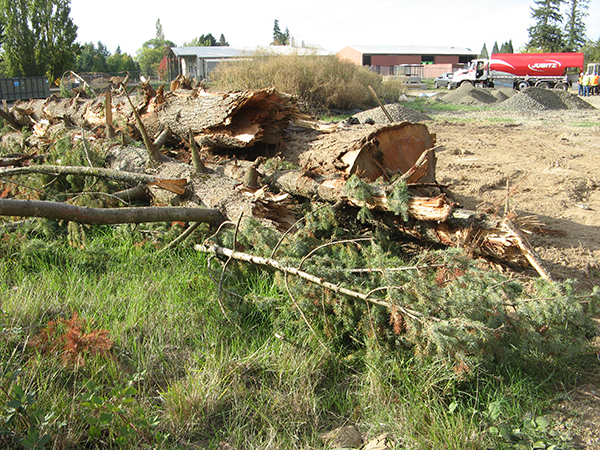This content was published: October 26, 2015. Phone numbers, email addresses, and other information may have changed.
Rock Creek Campus trees contribute to new wetlands restoration project
Photos and story by Katherine Miller

Fir trees recently removed for the construction of a new emergency-use egress road at PCC Rock Creek will soon help restore adjacent wetlands.
Three mature Douglas fir trees recently removed to make way for the construction of an emergency-use egress road at PCC Rock Creek will soon become an important part of a large wetlands restoration project there.
The wetlands restoration will be done just north of the egress road by Clean Water Services, a water resources management utility that protects the Tualatin River Watershed through wastewater and stormwater services, flood management projects, water quality and stream enhancement projects, fish habitat protection and more.
When completed in November, the egress road, part of the improvements funded by the 2008 voter-approved bond measure, will provide vital access for emergency vehicles between the west side of campus and Northwest 185th Avenue.
The wetlands will ultimately be a 90-acre continuous flood plain and include land owned by PCC as well as some property that borders the campus to the north, property for which Clean Water Services has permanent easements.
Tracey Dulin, water resources project manager for Clean Water Services, said that the agency’s field operations crews will partially bury the trunks of the fir trees horizontally in order to direct water flow.
“The restoration project’s goal is to improve the function of the wetlands and the flood plain,” said Dulin. “It’s currently degraded; water runs through the site very quickly, so we want to be able to store more water, and improve the complexity and diversity of the species there.“
In addition to the three fir trees removed for the egress road, the restoration project will use wood from trees elsewhere, both on and off campus. Dulin stressed that these trees all came down naturally, or were removed because they posed a hazard. “We like to re-use trees as much as possible so they won’t go to waste,” she said.
The different sizes and shapes of wood – including snags and stumps – will be used in a variety of ways to support everything from “cavity dwellers” like wood peckers to larger species such as great blue herons.
“Smaller pieces will be used to create wood or brush piles for habitat, to give the animals nooks and crannies to live in,” said Dulin. “We have some stumps as well that we’ll place out there that will add some texture to the flood plain and provide places for the birds to perch on.”
Although the project is still in the design and permitting stage, Dulin says it will probably be completed either summer of 2016 or 2017.
PCC’S 2008 voter-approved $374 million bond program is increasing opportunities for residents to access quality, affordable higher education close to where they live and work. Additional classrooms, updated equipment and technology, and advanced workforce training programs are helping to pave the way for future employment options. For more information, visit the bond website.
